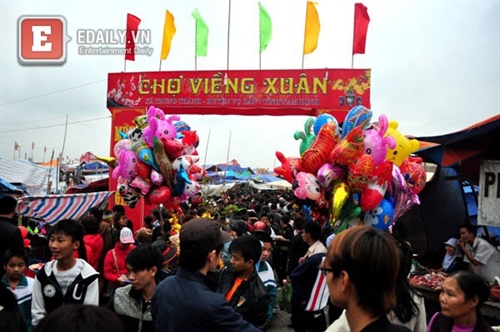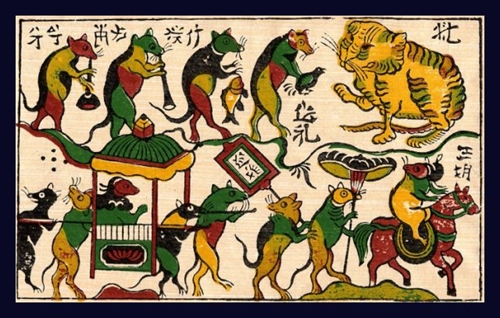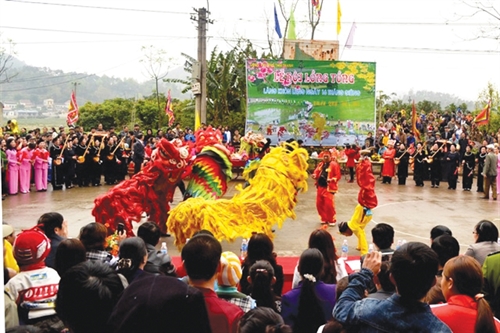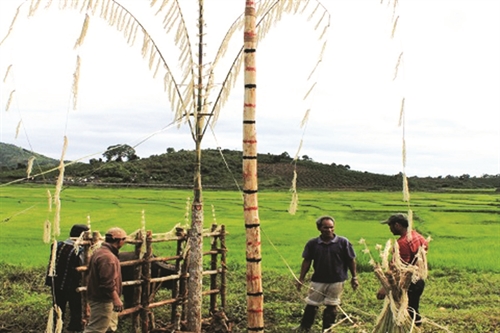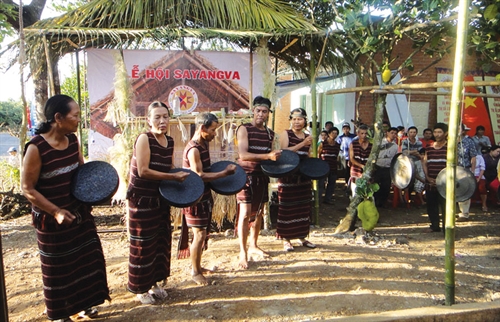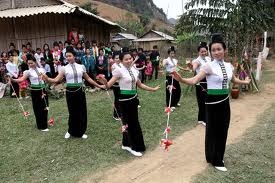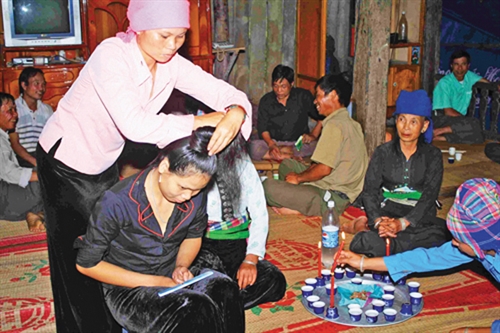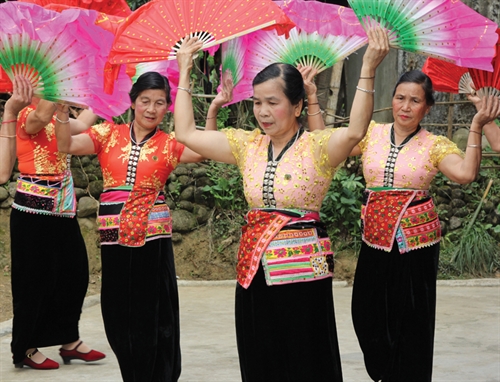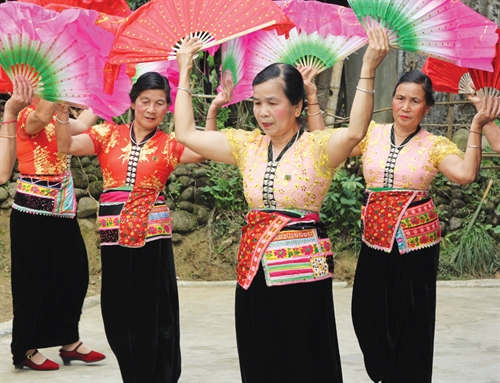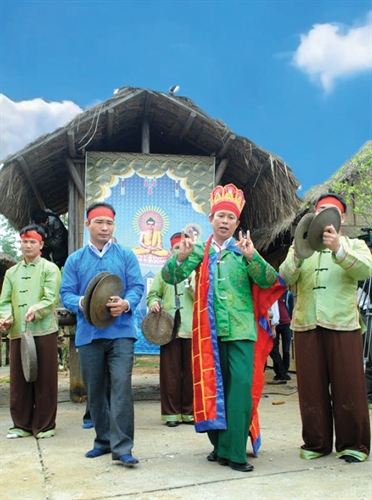Ta Thi Tam
Ethnology Institute
The Dao, an ethnic group who migrated to Vietnam from China in the 13th century, believe that the Jade Emperor (called Nhut Hung in their language) is the king of heaven ruling the sky, earth, sea and hell.
 |
Shamans blow horns in a le cap sac (maturity ceremony) to declare the commencement of the 12-lamp ceremony__Photo: Tuan An/VNA |
According to the group’s belief, the Jade Emperor is the leader of all deities, fairies and saints, having supernatural power over rain, thunder, lightning, water and fire. He has the power to order deities to carry out his intentions, usually good ones. He can also ordain deities or punishes fairies and saints.
Influenced by Taoism, the Dao think that the Jade Emperor was appointed by Nguyen Thuy Thien Ton when the earth and sky have just been formed. Nguyen Thuy Thien Ton held the highest position among the three supreme gods called Tam Thanh (Three Pure Ones), including Nguyen Thuy Thien Ton or Ngoc Thanh (governing the heaven), Thuong Thanh (ruling the earth) and Thai Thanh (ruling the hell). This trinity is the center of worship paintings of the Dao, which reflect their primitive concept of the universe and the relationship between human and other beings.
Dao people also believe the Jade Emperor, genies and Ban Vuong (the forefather of the group) always protect humans, conferring blessings and bumper crops. When suffering a misfortune or an illness, they think they are punished by genies who do not ward off evil spirits from causing troubles.
Legend of the Red Dao - a subgroup of Dao people, has it that a very long time ago all ethnic groups went on a quest for scriptures. As the Red Dao came first, the Jade Emperor passed them magic and a blowing horn (bugle) made from a buffalo horn. They were told to blow the horn four times to invite the Jade Emperor to witness their important events on earth when necessary.
Many ethnic groups of Vietnam have their own blowing horns but they are unique and sacred to the Red Dao’s worship rituals.
To make blowing horns, the Red Dao first select beautiful buffalo horns and leave them on a kitchen shelf or in a airy place to dry completely. Before making a blowing horn, the maker must select a good date to hold a ceremony to pray for the kitchen god’s blessing. The selected buffalo horn is cut to a length of around 30-40 cm and smoothed. A heated iron bar is used to drill a 2.5 cm-diameter hole on the pointed end of the buffalo horn for blowing. The other open end depends on the size of the horn. In the process of making a blowing horn, the maker will from time to time blow it in order to test its sound and fine-tune it by adjusting the blowing hole and open end of the horn. A good blowing horn is the one that, when blown in, produces a strong, sacred sound that can echo through the space to the Jade Emperor’s heavenly palace.
The Dao have many worship rituals to which the Jade Emperor and the Tam Thanh gods must be invited, including the great worship ritual dedicated to Ban Vuong, le cap sac (maturity ceremony), funerals and rituals to pray for bumper crops and happiness. These rituals must be conducted by a shaman who has passed le cap sac with at least seven lamps.
Le cap sac is divided into three levels: three lamps, seven lamps and twelve lamps, which indicates the number of lamps the person passing the ritual is granted. A Dao man usually passes le cap sac when he is between 15 and 20 years old. Only men passing le cap sac can become family heads and village chiefs and can worship ancestors.
During le cap sac, the most unique ritual of Dao people, the blowing horn is blown twice to invite the Jade Emperor to witness the ritual and to thank and send him off to the heavenly palace. It is the sole musical instrument that has the power to invite the Jade Emperor.
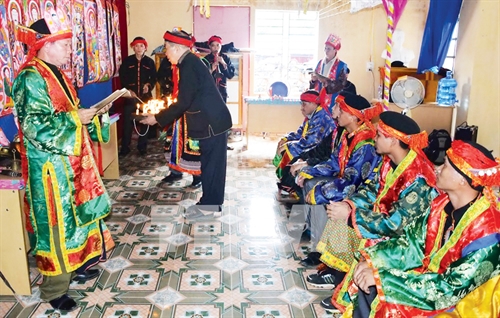 |
Offering-lamp ceremony to declare name and position of the man passing the cap sac ritual__Photo: Tuan An/VNA |
At the ceremony, the objects to be placed on the ancestor altar in the home include an incense burner, five cups of wine, a cup of water, a bottle of white liquor, a kerosene lamp, a ying yang set (a bowl and a ying yang coin), a wood stick, a blowing horn, a small sabre, two sets of worship paintings and a set of musical instruments including a trumpet, called pi le, drums, gongs and cymbals. Worshiping paper sheets, made from bamboo or glutinous rice straw and printed or stamped with bird-, tiger-, snake- and horse-riding human figures, are also indispensable.
A makeshift altar made of three straight trees is also set up in front of the entrance door of the house, on which an incense burner is placed. Beside it there is a large flat basket with worshiping paper sheets and objects.
To start the ritual, the shaman wearing an embroidered hat with a red cloth ribbon and the person passing le cap sac burn incense in front of the altar in the house to invite genies and ancestors to return home for the ceremony. Then, the shaman carrying the wood stick and blowing horn steps out of the house and stands on a wood plank to make four long blasts with the horn to invite the Jade Emperor. The first blast is meant to inform the heaven to open its door for the Jade Emperor to come down to the earth. The second is informing the earth to open its door for the Jade Emperor to enter. The third is officially inviting the Jade Emperor to the earth, informing the reason for invitation and showing him to his seat to witness the family affair. The fourth is informing the heavenly palace that the Jade Emperor and other deities have arrived on the earth and been solemnly welcome to witness and confer blessings to the earth.
Once everything finishes, the shaman makes four long blasts again to see off the Jade Emperor back to the heaven.
Blowing horns to invite the Jade Emperor to witness their important rituals is a unique cultural trait of the Red Dao people, making them always remember their roots.-
